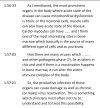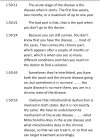- Home
- Forums
- Discussion topics
- Causes, Epidemiology, Criteria, Naming discussions
- Possible causes and predisposing factor discussion
You are using an out of date browser. It may not display this or other websites correctly.
You should upgrade or use an alternative browser.
You should upgrade or use an alternative browser.
Is the key pathology of ME/CFS in bone marrow?
- Thread starter Jonathan Edwards
- Start date
Dengue fever is also known as Break-bone fever, as it feels like all your bones are broken.
Be interesting if it, or any other disease with a similar symptom, have any genetic commonalities with ME/CFS.
Be interesting if it, or any other disease with a similar symptom, have any genetic commonalities with ME/CFS.
Pain in bones might be a good poll .Possibly. I was tempted to suggest that you 'feel ME/CFS in your bones' but decided it was a red mullet. Interestingly, apart from osetomyelitis and cancer deposits, pain from bone marrow is not often considered in medicine. In myeloma pain occurs when bones crumble but probably not just because of the plasma cells. I think it may be a red mullet.
Also perhaps " cold" bones ?
Jonathan Edwards
Senior Member (Voting Rights)
Could there be a relationship with hormones - in terms say of triggering mechanisms. I'm saying that as I have a vague memory that the norway study showed the rates for children are more even until adolescence.
There could certainly be a hormonal effect. Female sex hormones in pregnancy make RA better despite it being more common in women. They make lupus worse in pregnancy.
The role of sex chromosomes in disease is hugely complex. Some of it is just having those chromosomes at the time and some is having had them since conception and become male or female as a result and some is the interaction of the two. Yet more relates to coming and going of oestrogen and progesterone as a result - including pregnancy and menopause. If a double dose of TLR7 on two X chromosomes is important for chances of getting ME/CFS and lupus there is still plenty of room for hormonal status to determine when you get it.
Audrey Ryback says she has been replicating the age incidence data for European countries. I think this is going to be something important to focus on again. Audrey is staying over with us for the Nov 6 meeting.
Jonathan Edwards
Senior Member (Voting Rights)
What do you mean about 'highly sensitive to pressure change' Jonathan? What causes that pressure change?
If you put suction on red bone marrow by inserting a biopsy needle and pulling the syringe plunger it hurts like mad.
Pressure in bone marrow is a peculiar thing and I think has been invoked wrongly in certain conditions like avascular necrosis of the hip. I spent some years working on connective tissue hydrodynamics in the 1980s and learnt that there are very complex issues wherever you have a combination of solid and fluid phase components.
As long as exit venules from marrow are patent you cannot get much pressure change because the blood can just run out. Also bone marrow cannot swell because it is encased in bone. So pressure changes over periods of more than a second or so are unlikely to occur. Presumably suction during biopsy distorts the tissue over a few millimetres and pulls on nerves directly.
Can confirm the horror. I remember the feeling of pulling and pressure during the biopsy. Most painful thing ever.If you put suction on red bone marrow by inserting a biopsy needle and pulling the syringe plunger it hurts like mad.
I have no bone pain during PEM although at ME onset I had months of general feeling of ache/ pressure in chest area that seemed to be part of the bones.
Utsikt
Senior Member (Voting Rights)
Maybe having some kind of idea about what’s going on in there? It would be difficult to help a body part if it’s essentially a black boxI was reading that there are sympathetic nerves and nociceptive nerves in the bone marrow. And something about nociceptive nerves responding to 'neurotoxic agents'. I'm not sure what the point of having nociceptive nerves in bone marrow is.
V.R.T.
Senior Member (Voting Rights)
So apparantly (repeating myself from another thread here) according to Michelle James' Stanford talk, someone (it wasn't clear which group) is looking at OX40, a CD4 and CD8 T Cell marker, in a PET study.
If that can show the bone marrow, perhaps that might give us some clues?
If that can show the bone marrow, perhaps that might give us some clues?
Interesting to see comments about the pain being prominent in the lower legs. I get that too.
How it affects the dynamic management of mechanical forces within the body, and what happens if that finely balanced system goes wrong, and how to detect it, is something I have often wondered about.
Phase changes in biological structures is a very interesting question.I spent some years working on connective tissue hydrodynamics in the 1980s and learnt that there are very complex issues wherever you have a combination of solid and fluid phase components.
How it affects the dynamic management of mechanical forces within the body, and what happens if that finely balanced system goes wrong, and how to detect it, is something I have often wondered about.
Kitty
Senior Member (Voting Rights)
Pain in bones might be a good poll .
I wonder if it might be quite difficult to identify?
I often get 'bone pain' in my arms, which is really naggy deep in the elbow joint. But it's caused by ulnar nerve impingement from using computers and playing music (shoulder and wrist joints are unhelpfully loose). No nerve impingement, no bone ache.
I also remember a relative complaining of bone pain in her legs at one point. She later needed treatment for breast cancer, one element of which was known for causing bone pain, and she said she'd never experienced anything like it before. She decided that whatever her leg pain had been, it probably wasn't bone pain.
Prusty has mentioned bone marrow, for instance here (from 1:56:33):Hasn't Prusty been thinking along these lines?
Also of course Fluge and Mella must be because bone marrow is where LLPCs live.
Verbatim transcript of Prof. Bhupesh Prusty’s presentation to the Fatigatio E.V Research Seminar – 14th Sept. 2024
https://docs.google.com/document/d/1T79bGDR1w31zHhS39AXz3wDyhlmvwadg/mobilebasic
Last edited by a moderator:
Jonathan Edwards
Senior Member (Voting Rights)
Prusty has mentioned bone marrow, for instance here (from 1:56:33):
I cannot make much sense of that I am afraid.
I have no idea what he means by acute state of disease.
Kitty
Senior Member (Voting Rights)
Verbatim transcript of Prof. Bhupesh Prusty’s presentation to the Fatigatio E.V Research Seminar – 14th Sept. 2024
Is there anything in that statement that we actually know to be the case?
Maybe acute viral infection, as he talks about it staying latent in the bone marrowI cannot make much sense of that I am afraid.
I have no idea what he means by acute state of disease.
Never heard of viruses staying in the bone marrow, is that proven?
Utsikt
Senior Member (Voting Rights)
Apparently they’ve found viral DNA in bone marrow post mortem, but that might not mean active viruses.Maybe acute viral infection, as he talks about it staying latent in the bone marrow
Never heard of viruses staying in the bone marrow, is that proven?
The Human Bone Marrow Is Host to the DNAs of Several Viruses - PMC
The long-term impact of viruses residing in the human bone marrow (BM) remains unexplored. However, chronic inflammatory processes driven by single or multiple viruses could significantly alter hematopoiesis and immune function. We performed a ...
He talks about ME and distinguishes between an acute and a chronic state.I cannot make much sense of that I am afraid.
I have no idea what he means by acute state of disease.
Last edited by a moderator:
Jonathan Edwards
Senior Member (Voting Rights)
He talks about ME and distinguishes between an acute and a chronic state.
I see. I still have no idea what he is talking about!
I've learned, from teeth and various other pains, that I am really terrible at correctly identifying where the pain is located. I was sure the pain was from one tooth, but it turned out the neighbour was cracked. My present foot pain feels like it's coming from the top of the foot, but it's actually a cyst much lower down, pressing on a nerve there. I expect this misidentification of pain sources is common in humans. So, a poll about bone pain isn't likely to provide useful information.Pain in bones might be a good poll .
I have had that "pain in my bones" feeling, but I had that before ME too, and I doubt that it was caused by problems in the bones. I think it's more likely something making the brain cells that process those nerve signals more sensitive.


